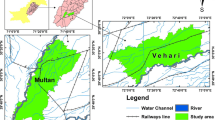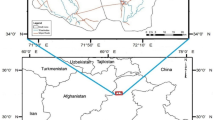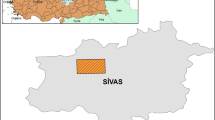Abstract
Urban growth and the changing scenario of Land Use and Land Cover (LULC) have been an increasing trend in both towns and cities. The higher rate of transformation from non-built up land to the impervious area becomes a warning symbol of Land surface temperature variations. In this study, an attempt has been made to determine the transition of natural land area and its impact on Land surface temperature (LST) in Vellore district, Tamil Nadu, India. According to the current statistics, the study area records the hottest climate crossing 40° mark in recent years. This is mainly due to the minimum rainfall, the ground level is 200 m just above the sea level, and the pollution caused by tanneries. Landsat imageries are collected for three different years 1994, 2002, and 2018 that map the LULC into agricultural, water bodies, built-up land, and barren land classes. The major purpose of this research is to (i) analyze changes of LULC in and around Vellore city, (ii) categorize the images into various classes like vegetative and non-vegetative land, (iii) Assessment of Spatio-temporal variations in LST and link with classes and urbanization growth using satellite images. The LULC impact on LST is analyzed with the widely used Getis–Ord statistics. The simulation result shows that the built-up area raises to 81%, vegetation land decline by about −65% for the years 1994–2018 respectively. It is observed that LST has attained the highest degree in the built-up class due to the unplanned LULC changes and the conversion of built-up areas. The overall accuracy is achieved at about 92, 89, and 91% for three different years respectively. Based on the obtained result, this can be adopted for the development of rural, and urban areas in the coming future.












Similar content being viewed by others
References
Balogun, I., & Ishola, K. (2017). Projection of future changes in landuse/landcover using cellular automata/markov model over Akure city, Nigeria. Journal of Remote Sensing Technologies, 5, 22–31.
Choudhury, D., Das, K., & Das, A. (2019). Assessment of land use land cover changes and its impact on variations of land surface temperature in Asansol-Durgapur Development Region. The Egyptian Journal of Remote Sensing and Space Science, 22(2), 203–18 (2019).
Das, S., & Angadi, D. P. (2020). Land use-land cover (LULC) transformation and its relation with land surface temperature changes: A case study of Barrackpore Subdivision, West Bengal, India. Remote Sensing Applications: Society and Environment, 19, 100322.
Fonseka, H. P., Zhang, H., Sun, Y., Su, H., Lin, H., & Lin, Y. (2019). Urbanization and its impacts on land surface temperature in Colombo metropolitan area, Sri Lanka, from 1988 to 2016. Remote Sensing, 11(8), 957.
Ghosh, J., & Porchelvan, P. (2017). Remote sensing and GIS technique enable to assess and predict landuse changes in Vellore district, Tamil Nadu, India. IJAER, 12(12), 3474–3482.
Gohain, K. J., Mohammad, P., & Goswami, A. (2021). Assessing the impact of land use land cover changes on land surface temperature over Pune City, India. Quaternary International, 575, 259–269.
Grigoraș, G., & Urițescu, B. (2019). Land use/land cover changes dynamics and their effects on surface urban heat island in Bucharest, Romania. International Journal of Applied Earth Observation and Geoinformation, 80, 115–126.
Hart, M. A., & Sailor, D. J. (2009). Quantifying the influence of land-use and surface characteristics on spatial variability in the urban heat island. Theoretical and Applied Climatology, 95(3), 397–406.
Huang, Q., & Lu, Y. (2018). Urban heat island research from 1991 to 2015: A bibliometric analysis. Theoretical and Applied Climatology, 131(3), 1055–1067.
John, J., Bindu, G., Srimuruganandam B, Wadhwa A, & Rajan P. (2020). Land use/land cover and land surface temperature analysis in Wayanad district, India, using satellite imagery. Annals of GIS, pp. 1–8.
Kafy, A. A., Rahman, M. S., Hasan, M. M., & Islam, M. (2020). Modelling future land use land cover changes and their impacts on land surface temperatures in Rajshahi, Bangladesh. Remote Sensing Applications: Society and Environment, 18, 100314.
Lilly Rose, A., & Devadas, M. D. (2009). Analysis of land surface temperature and land use/land cover types using remote sensing imagery-a case in Chennai City, India. In: Proceedings of the 7th International Conference on Urban Climate (ICUC-7), Yokohama, Japan, p. 29.
Madanian, M., Soffianian, A. R., Koupai, S. S., Pourmanafi, S., & Momeni, M. (2018). The study of thermal pattern changes using Landsat-derived land surface temperature in the central part of Isfahan province. Sustainable Cities and Society., 39, 650–661.
Maimaitiyiming, M., Ghulam, A., Tiyip, T., Pla, F., Latorre-Carmona, P., Halik, Ü., Sawut, M., & Caetano, M. (2014). Effects of green space spatial pattern on land surface temperature: Implications for sustainable urban planning and climate change adaptation. ISPRS Journal of Photogrammetry and Remote Sensing, 89, 59–66.
Nagamani, K., & Manoharan, N. Multi-temporal land use/land cover change detection in semi urban vellore district using landsat tm and ETM+ DATA.
Nayak, S., & Mandal, M. (2019). Impact of land use and land cover changes on temperature trends over India. Land Use Policy, 89, 104238.
Pan, X. Z., Uchida, S., Liang, Y., Hirano, A., & Sun, B. (2010). Discriminating different landuse types by using multitemporal NDXI in a rice planting area. International Journal of Remote Sensing, 31(3), 585–596.
Piyoosh, A. K., & Ghosh, S. K. (2020). Analysis of land use land cover change using a new and existing spectral indices and its impact on normalized land surface temperature. Geocarto International, pp. 1–23.
Piyoosh, A. K., & Ghosh, S. K. (2018). Development of a modified bare soil and urban index for Landsat 8 satellite data. Geocarto International, 33(4), 423–42 (2018).
Piyoosh, A. K., & Ghosh, S. K. (2017). Semi-automatic mapping of anthropogenic impervious surfaces in an urban/suburban area using Landsat 8 satellite data. Giscience and Remote Sensing, 54(4), 471–494.
Prabu, M., & Anouncia, S. M. (2018). Prediction of Land Cover Changes in Vellore District of Tamil Nadu by Using Satellite Image Processing. InKnowledge Computing and its Applications Springer, Singapore, 87–100.
Pramit, V., Aditya, R., Srivastava, P. K., & Raghubanshi, A. S. (2020). Appraisal of kappa-based metrics and disagreement indices of accuracy assessment for parametric and nonparametric techniques used in LULC classification and change detection. Modeling Earth Systems and Environment., 6(2), 1045–1059.
Raghavan, K., Mandla, V., & Franco, S. (2015). Influence of urban areas on environment: Special reference to building materials and temperature anomalies using geospatial technology. Sustainable Cities and Society., 219, 349–358.
Shi, Y., & Zhang, Y. (2018). Remote sensing retrieval of urban land surface temperature in hot-humid region. Urban Climate., 24, 299–310.
Tariq, A., Riaz, I., Ahmad, Z., Yang, B., Amin, M., Kausar, R., Andleeb, S., Farooqi, M. A., & Rafiq, M. (2020). Land surface temperature relation with normalized satellite indices for the estimation of spatio-temporal trends in temperature among various land use land cover classes of an arid Potohar region using Landsat data. Environmental Earth Sciences., 79(1), 1–5.
Thakur, S., Maity, D., Mondal, I., Basumatary, G., Ghosh, P. B., Das, P., & De, T. K. (2021). Assessment of changes in land use, land cover, and land surface temperature in the mangrove forest of Sundarbans, northeast coast of India. Environment, Development and Sustainability., 23(2), 1917–2439.
Ullah, S., Tahir, A. A., Akbar, T. A., Hassan, Q. K., Dewan, A., Khan, A. J., & Khan, M. (2019). Remote sensing-based quantification of the relationships between land use land cover changes and surface temperature over the Lower Himalayan Region. Sustainability., 11(19), 5492.
Uttara, S., Bhuvandas, N., & Aggarwal, V. (2012). Impacts of urbanization on environment. International Journal of Research in Engineering and Applied Sciences, 2(2), 1637–45 (2012).
Vohra, R., & Tiwari, K. C. (2020). Comparative Analysis of SVM and ANN Classifiers using Multilevel Fusion of Multi-Sensor Data in Urban Land Classification. Sensing and Imaging, 21(1), pp. 1–21.
Vohra, R., & Tiwari, K. C. (2019). Spatial shape feature descriptors in classification of engineered objects using high spatial resolution remote sensing data. Evolving Systems, pp. 1–4.
Wang, R., Cai, M., Ren, C., Bechtel, B., Xu, Y., & Ng, E. (2019). Detecting multi-temporal land cover change and land surface temperature in Pearl River Delta by adopting local climate zone. Urban Climate, 28, 100455.
Wang, S., Ma, Q., Ding, H., & Liang, H. (2018). Detection of urban expansion and land surface temperature change using multi-temporal landsat images. Resources, Conservation and Recycling, 128, 526–534.
Yuan, F., & Bauer, M. E. (2007). Comparison of impervious surface area and normalized difference vegetation index as indicators of surface urban heat island effects in Landsat imagery. Remote Sensing of Environment., 106(3), 375–386.
Zhang, Y., Odeh, I. O., & Han, C. (2009). Bi-temporal characterization of land surface temperature in relation to impervious surface area, NDVI and NDBI, using a sub-pixel image analysis. International Journal of Applied Earth Observation and Geoinformation, 11(4), 256–264.
Acknowledgements
Not applicable.
Funding
There is no funding for this study.
Author information
Authors and Affiliations
Contributions
All the authors have participated in writing the manuscript and have revised the final version. All authors read and approved the final manuscript.
Corresponding author
Ethics declarations
Conflict of interest
Authors declare that they have no conflict of interest.
Human and animal participants
This article does not contain any studies with human participants and/or.
animals performed by any of the authors.
Consent to participate
There is no informed consent for this study.
Consent for publication
Not applicable.
Additional information
Publisher's Note
Springer Nature remains neutral with regard to jurisdictional claims in published maps and institutional affiliations.
Rights and permissions
About this article
Cite this article
Vohra, R., Tiwari, K.C. Analysis of land use and land cover changes and their impact on temperature using landsat satellite imageries. Environ Dev Sustain 25, 8623–8650 (2023). https://doi.org/10.1007/s10668-022-02416-1
Received:
Accepted:
Published:
Issue Date:
DOI: https://doi.org/10.1007/s10668-022-02416-1




